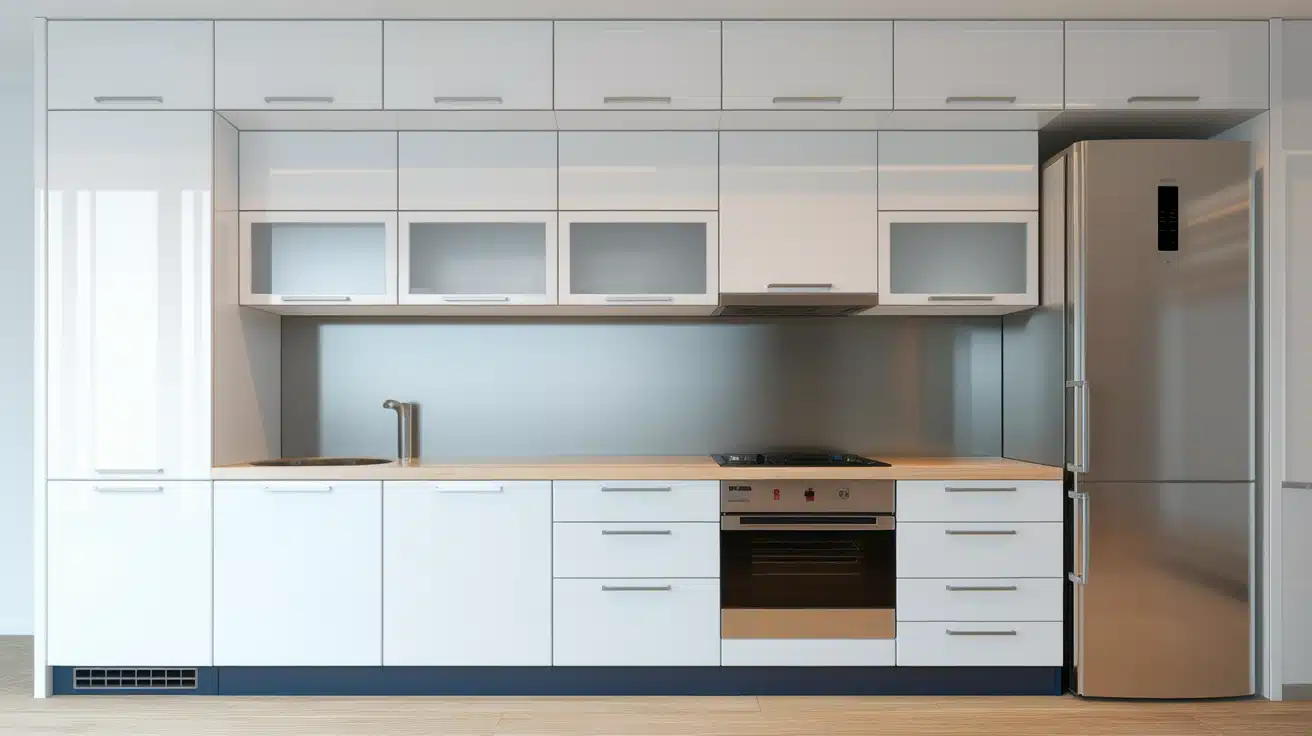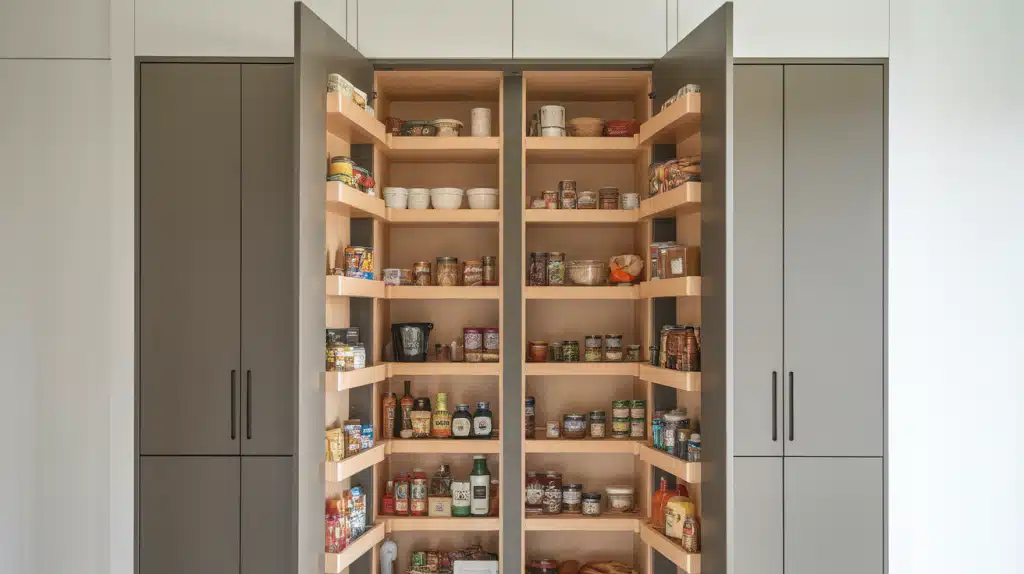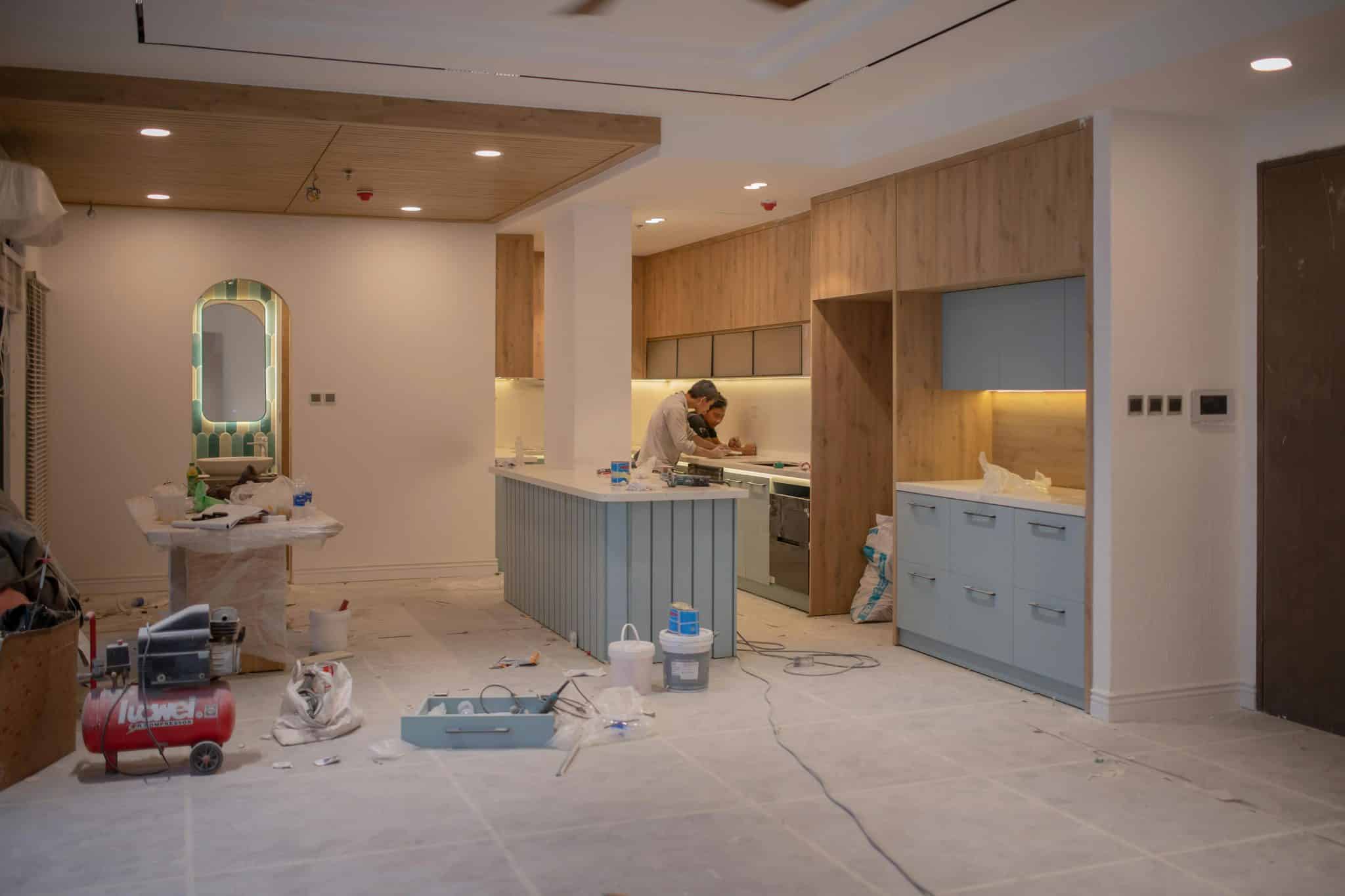Planning a kitchen renovation and feeling overwhelmed by cabinet measurements? I’ve been there too.
Most homeowners focus on cabinet width and height, but depth is what really makes or breaks your kitchen’s functionality. Get it wrong, and you’ll struggle with storage access and appliance fit for years.
The good news? Understanding cabinet depth is simpler than you think. Standard measurements exist for a reason, and once you know them, planning becomes straightforward.
I’ll walk you through every cabinet depth you need to know, from base cabinets to wall cabinets, plus the important exceptions that can make or break your design. Let’s make your kitchen planning stress-free.
Cabinet Types & Their Dimensions
Understanding cabinet sizes helps you plan your kitchen layout better. Here are the standard measurements for each type:
1. Standard Kitchen Cabinet Dimensions
The standard cabinet sizes help guide planning before taking custom measurements. These dimensions serve as starting points for most kitchen designs.
| Type of Cabinet | Common Heights | Common Depths | Common Widths |
|---|---|---|---|
| Base Cabinets | 34.5″ (no countertop), 36″ (with countertop) | 21″ or 24″ (up to 33″ in corners) | 12″ to 42″ (also 6″, 9″ fillers) |
| Wall Cabinets | 30″, 36″, 42″ | 12″ (24″ above fridge) | 12″ to 36″ (also 3″, 6″, 9″ fillers) |
| Tall Cabinets | 84″, 90″, 96″ | 12″ (pantry), 24″ (utility) | 18″ to 33″ |
2. Kitchen Base Cabinet Dimensions

Base cabinets serve as the foundation of kitchen storage, providing support for countertops. Accurate measurements ensure proper fit and functionality.
| Dimension | Standard Size |
|---|---|
| Height | 34.5″ (without countertop), 36″ (with countertop) |
| Depth | 24″ standard, 21″ compact |
| Width | 12″ to 42″(6″ increments) |
Base cabinets provide the most storage space in your kitchen. They have drawers, shelves, and pull-out organizers. Most base cabinets include adjustable shelves that can be moved up or down. The toe kick at the bottom creates a comfortable standing position while cooking.
3. Kitchen Wall (Upper) Cabinet Dimensions
Wall cabinets provide lightweight storage and significantly impact the kitchen’s appearance. Measure wall cabinets after selecting base cabinets and countertops for accurate planning.
| Dimension | Standard Sizes |
|---|---|
| Height | 30″, 36″, 42″ |
| Depth | 12″ (regular wall cabinets), 24″ (over fridge/microwave) |
| Width | 12″, 15″, 18″, 24″, 27″, 30″, 33″, 36″, Extra small fillers: 3″, 6″, 9″ |
Choose taller wall cabinets for more storage or shorter ones for easier access. Install them 18 inches above your countertop for comfortable use. Glass doors on wall cabinets can make your kitchen feel more open and spacious.
4. Pantry Dimensions
Tall cabinets maximize vertical space for pantry storage, broom closets, and appliance storage. These floor-to-ceiling units provide significant storage capacity in minimal floor space.
| Dimension | Standard Options |
|---|---|
| Height | 84″, 90″, 96″ |
| Depth | 12″ (pantry), 24″ (utility) |
| Width | 18″, 24″, 30″, 33″ |
These cabinets maximize vertical space and keep your kitchen organized. They often feature multiple shelves and sometimes include pull-out drawers for improved access. Tall cabinets work well in corners where wall and base cabinets may not fit perfectly.
How to Measure Kitchen Cabinet Dimensions?
Accurate measurements are essential for successful cabinet installation. Proper planning prevents costly mistakes and ensures everything fits correctly.
1. Width Measurements
Width measurements require measuring wall space from corner to corner at multiple heights. Walls are rarely perfectly straight, so checking at different levels prevents fitting problems.
- Use the smallest measurement to ensure proper fit
- Measure at three different heights on each wall
- Record all measurements and note variations
2. Height Measurements
Start from floor to ceiling at several points along each wall. Floor and ceiling irregularities can significantly impact the installation of cabinets.
- Standard ceiling height is 8 feet
- Check for sloped floors or uneven ceiling lines
3. Depth Measurements
Check how far cabinets can extend into the room. This determines how much storage space is available without blocking movement.
- Consider traffic flow patterns
- Account for door swing clearances
Taking precise measurements at multiple points ensures cabinets fit properly and function well in the kitchen space.
When to Consider Different Depths of Kitchen Cabinets?
Sometimes standard depths don’t work. Cabinets above refrigerators often extend to 24 inches deep to match the appliance below. This extra depth works here because you typically store less-used items like holiday platters or bulk supplies.
In tight kitchens, 21-inch base cabinets save precious floor space while still fitting most items. For pantry storage, 12-inch deep tall cabinets keep food visible and accessible without wasting space.
The key is matching depth to function. High-use areas need standard depths for comfort, while special situations benefit from custom measurements.
Standard vs Custom Cabinets: Making the Right Choice
Kitchen layouts require careful planning to make the most of available space. Understanding different cabinet options and placement strategies helps create functional cooking areas.
Standard Sizes vs. Semi-Custom/Custom for Irregular Spaces:
| Cabinet Type | Cost Level | Best For |
|---|---|---|
| Standard | Lowest | Typical rooms, budget projects |
| Semi-Custom | Medium | Odd measurements, specific needs |
| Custom | Highest | Unique layouts, high-end projects |
Standard cabinets work well for most kitchens and provide good value. Semi-custom options bridge the gap between standard and fully custom solutions. Custom cabinets fit any space perfectly but cost significantly more.
Conclusion
Understanding how deep kitchen cabinets should be doesn’t have to be complicated. I’ve covered the key measurements you need: base cabinets for solid support and storage, wall cabinets for comfortable reach, and deeper options above refrigerators when you need extra space.
These standard depths exist because they work. They balance storage capacity with accessibility, ensure appliances fit properly, and create kitchens that feel comfortable to use every day.
Ready to put this knowledge into action?
Start by measuring your current space and identifying which areas need the most storage.
Remember, the right cabinet depth can make the difference between a kitchen that works against you and one that makes cooking a joy.
Explore my other Kitchen & Dining blogs for expert tips, smart upgrades, and style inspiration.
Frequently Asked Questions
How Deep Is an Average Kitchen Cabinet?
Base cabinets are typically 24 inches deep, while wall cabinets are 12 inches deep. These standard depths work for most kitchens and appliances.
Are All Upper Cabinets 12 Inches Deep?
No, most wall cabinets are 12 inches deep, but cabinets above refrigerators can be up to 24 inches deep for extra storage space.
Does the Depth of A Kitchen Cabinet Include the Door?
Yes, cabinet depth measurements include the door and frame. The measurement goes from the back wall to the front of the closed door.










